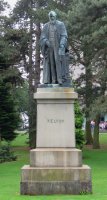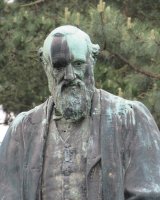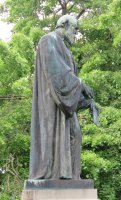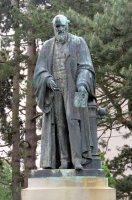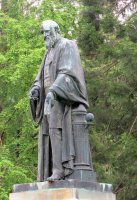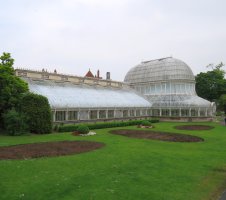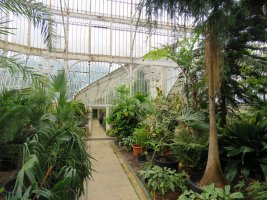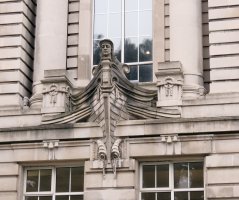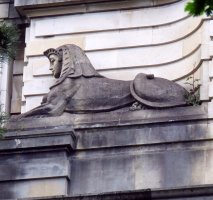Lord Kelvin, by Albert Bruce Joy, and the Botanic Gardens, Belfast
In Belfast Botanic Gardens stands an important bronze statue of Lord Kelvin, by the eminent Belfast-born sculptor Albert Bruce-Joy. Nearby is the early Victorian Palm House, and the Ulster Museum building of 1929.
The statue of Lord Kelvin
Lord Kelvin, by Albert Bruce-Joy of Dublin, 1913.
A noble portrait statue in bronze, of large size, of the scientist Lord Kelvin (William Thomson), after whom the Kelvin scale of absolute temperature is named, stands in the beautiful Botanic Gardens in Belfast, the city where Kelvin was born. The statue is the work of the Irish-born sculptor Albert Bruce-Joy. Kelvin is shown in later middle age, with downward turned head, emphasising his great forehead, his eyes staring, lost deep in profound thought. He has a full beard, and wears an academic cloak with full arms, open at the front to show his waistcoat. He holds in one hand a stylus, in the other a book or pad with a sketch of an atomic vortex – a later disproved theory concerning the structure of atoms, and perhaps an odd choice for such a prolific inventor and thinker, in the fields of physics and engineering. By him is a short pillar or pedestal, partially covered by sleeve and cloak, with a projection bearing a sphere, perhaps indicative of his work on thermodynamics and movement of heat between bodies. The effect overall from in front of the statue is one of massiveness, yet from the side, his stooped pose suggests the aged professor, perhaps a nod to his role for over half a century in Glasgow University. The statue stands on a square stone plinth, raised on steps.
Kelvin statue by Bruce-Joy, different aspects.
Albert Bruce-Joy has another statue in Dublin, which I have not seen, James Whiteside, in the Cathedral. Among his various portrait statues on the mainland, that of Balfour in Liverpool (see this page) is somewhat similar in spirit to the Kelvin one, with not dissimilar pose and again the great cloak to give bulk and presence to the Victorian figure. The Kelvin statue, dating from 1913, was made towards the end of Bruce-Joy’s career.
Belfast Palm House
Palm House, by Charles Lanyon, 1839.
The Palm House, built very early in Queen Victoria’s reign, from 1839, is a super thing, with an almost ogee-curved shape, most satisfying to behold. It was designed by the architect Charles Lanyon, who has many buildings across Belfast, notably including the vast Queens University building which the pedestrian passes on the way to the Botanic Gardens from the city centre. The builder was Richard Turner, who went on a few years later to build the much larger Palm House in Kew Gardens. Inside, there is a modern wooden carving of a crouched girl.
Ulster Museum
Art Deco carvings on facade of Ulster Museum.
The Ulster Museum stands in the grounds and adjacent to the Gardens. The main building was designed before WW1 but only put up in the late 1920s (though there is a lumpish brutalist extension), and so whle the building is Classical, the carved detail upon it is rather Art Deco, most notably including a ship’s prow with a somewhat grim head under a window, and a good pair of sphinxes high up above. We may note a modern abstract piece of steel slabs, by Barry Flanagan, best known (to me at least) for his carvings of hares and a settler in Dublin rather than a native, despite his name. Within the museum are art and archaeological collections, including good Celtic work , alongside modern history, natural history and other non-artistic things.
Along the road towards the city centre is Queen's University, with a war memorial by Thomas Brock - see this page. See also other Belfast sculpture and sculptors.
